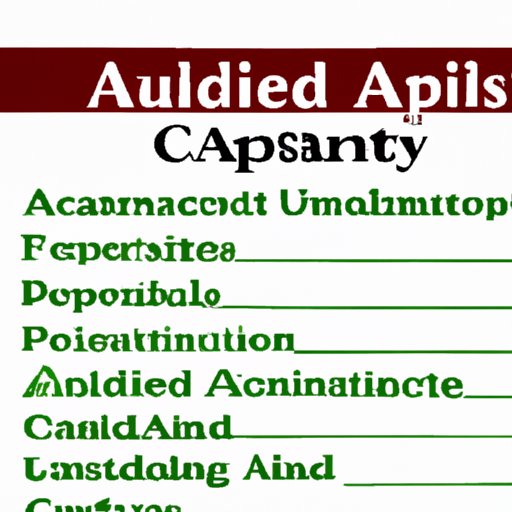Introduction
A financial aid appeal is an opportunity for students to request additional funding from their college or university due to extenuating circumstances. If accepted, this additional funding can help reduce the burden of tuition costs and other expenses associated with higher education. In order to make a successful appeal, it is essential to write a compelling personal statement that outlines the need for additional funding and demonstrates why the student should receive it.

Outline the Components of a Successful Financial Aid Appeal
When crafting a financial aid appeal, it is important to understand what makes an effective appeal. According to the National Association of Student Financial Aid Administrators (NASFAA), “the basic principle underlying all appeals is that the student must demonstrate that there has been a significant change in his or her financial situation since the original FAFSA was filed.” This means that the student must provide evidence of why they now require additional funding to cover the cost of their education.
In addition to proof of a changed financial situation, a successful financial aid appeal should also include:
- A detailed explanation of the circumstances leading to the need for additional funds
- An outline of the steps the student is taking to address the issue
- Evidence of any extenuating circumstances beyond the student’s control
- A clear and concise plan for how the additional funding will be used
Explain the Process for Writing a Personal Statement for Financial Aid
Once the student has gathered the necessary documentation, they can begin the process of writing a personal statement for the financial aid appeal. The first step is to clearly explain the situation and why additional funding is needed. It is important to be honest and direct, as the committee needs to understand the full scope of the student’s financial hardship. The statement should also include any extenuating circumstances that have contributed to the student’s current financial situation.
The next step is to outline the steps the student is taking to address the issue. This could include working more hours, taking out a loan, or applying for additional scholarships. It is important to emphasize the student’s commitment to finding a solution and illustrate how the additional funding will help them reach their educational goals.
Finally, the statement should include a detailed plan for how the additional funding will be used. This could include covering tuition costs, living expenses, or any other related costs. By providing a comprehensive plan, the committee will be able to better understand the student’s needs and make an informed decision about the appeal.

Provide Tips on How to Make Your Appeal Stand Out
In order to make the financial aid appeal stand out, it is important to highlight any unique qualities or experiences that set the student apart. This could include highlighting volunteer experience, academic achievements, or any other accomplishments that demonstrate the student’s dedication to their education. Additionally, it is important to showcase the student’s commitment to finding a solution to their financial situation. This could include a detailed plan for how they will manage their finances going forward, or any steps they have already taken to alleviate their financial burden.
Share Examples of Effective Financial Aid Appeals
To help illustrate the components of a successful financial aid appeal, it is helpful to look at examples of real-life appeals. One example comes from the University of California, Davis, which provides a sample appeal letter written by a student who experienced a sudden and unexpected change in their family’s financial situation. In the letter, the student explains their situation in detail and outlines the steps they are taking to address the issue. They also provide evidence of the extenuating circumstances, such as medical bills, and a plan for how the additional funding will be used.
Another example comes from the University of Massachusetts Amherst, which provides a sample appeal letter written by a student whose parents experienced a decrease in income due to COVID-19. In the letter, the student outlines the specific circumstances that led to the decrease in income and provides evidence of their parents’ financial hardship. They also explain the steps they are taking to address the issue and provide a detailed plan for how the additional funding will be used.

Guide Readers Through Crafting Their Own Personal Statements
Once the reader has seen examples of successful financial aid appeals, the next step is to guide them through crafting their own personal statement. One way to do this is to offer strategies for brainstorming ideas. This could include making a list of the extenuating circumstances and outlining the steps the student is taking to address the issue. It is also helpful to suggest ways to structure the statement, such as beginning with an introduction, then addressing the financial hardship, and finally outlining the plan for how the additional funding will be used.
It is also important to offer tips for revising the statement. This could include reading the statement aloud to identify any awkward phrasing or unclear language. Additionally, it is helpful to have another person review the statement to provide feedback and point out any areas that could be improved upon.
Conclusion
Writing a personal statement for a financial aid appeal can be an intimidating task. However, by understanding the components of a successful appeal, highlighting unique qualities and experiences, and following the above tips, students can craft an effective statement that stands out from the crowd. By doing so, they can give themselves the best chance at receiving the additional funding they need to pursue their educational goals.
(Note: Is this article not meeting your expectations? Do you have knowledge or insights to share? Unlock new opportunities and expand your reach by joining our authors team. Click Registration to join us and share your expertise with our readers.)
